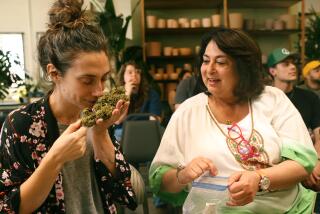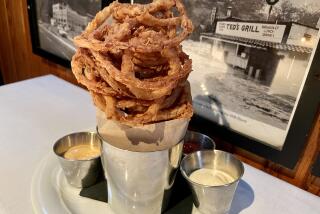Dig Into a Good Plot and Come Up With Tear-Jerker
Home-grown onions are crisp, juicy and far superior to store-bought kinds. Just ask anyone who’s planted them.
And now’s the time to dig in.
“Although onions can be grown most of the year in Southern California, this is an excellent time to plant them,” said certified nursery professional Debbie Woolley, assistant manager at Armstrong Garden Center in Santa Ana.
Onions can be planted by seed or sets, which are miniature, dormant onion bulbs. Nurseries should have a good supply of sets in stock now. Seeds can be found throughout the year in nurseries and through mail-order catalogs.
Sets come in yellow, white or red. You can find a wider variety in seeds.
In red onions there are early California and Burgermaster. Texas early Grano, early yellow globe, Walla Walla sweet and sweet Spanish are all yellows. White onions include Southport white glove and white sweet Spanish.
Most onion sets take 60 to 80 days to produce full-sized onions, while seeds take up to 120 days. However, you don’t need to wait until onions are full-grown. Within a month to six weeks after planting sets, you will have eating-size green onions.
“Many gardeners plant onions close together and use the thinnings as green onions, leaving room for the remaining onions to grow full size,” said Woolley, who suggests the following tips:
* Plant onions in full sun.
* Provide onions with soft, fluffy soil. Rocky, compacted soil will cause onions to become distorted and stunted.
Improve the soil by adding a soil conditioner or mulch at a rate of 50%. Gypsum will also help to break up the clay and add calcium to the soil. Work all amendments in a foot deep.
* Ensure that your onions have good drainage, or they will rot. To slow-draining soil add perlite. Or try containerizing onions. The drainage in pots is excellent, and no soil preparation is necessary. Use a high-quality potting soil.
* Plant sets 1 to 2 inches deep with 18 to 24 inches between rows. They should be placed in the soil with the pointy part up and the rounded base down. If you will be thinning them when they reach green onion size, plant them a half inch apart and thin to 4 to 6 inches apart.
* Plant seeds a half-inch deep, about an inch apart, with 18 to 24 inches between rows. As they sprout, thin them until they are four to 6 inches apart.
* Don’t over- or underwater. Over-watered plants will rot, while under-watered onions won’t thrive. Water new plants often. Once the weather cools off and the soil continues to stay moist, a good soak once or twice a week is usually sufficient.
* Fertilize at planting time and six weeks into the growing season. Use an organic vegetable fertilizer such as a 4-5-3.
* Harvest mature onions when the tops start turning yellow and bending over. Push the leaves flat to the ground and let them dry completely. Then dig the onions up, clean them and put them in the sun for three or four days to dry.
After drying, they can be hung by their stems in a cool, dry place, stored in a mesh bag or put in the refrigerator. Stored properly, onions will last for months.
(BEGIN TEXT OF INFOBOX / INFOGRAPHIC)
SEPTEMBER PLANTING LIST
Though this month is usually hot and dry in the garden, it’s time to begin planting fall and winter crops. Wait until the middle of the month to put in some of the more heat-sensitive plants. While the weather remains hot, regular watering is critical. New seedlings and transplants may need watering twice a day.
FLOWERS
African daisy
Alstroemeria
Alyssum
Bachelor button
Bells of Ireland
Calendula
Candytuft
Canterbury bell
Carnation
Chrysanthemum
Columbine
Delphinium
English daisy
Foxglove
Godetia
Hollyhock
Impatien
Larkspur
Nicotiana
Pansy
Penstemon
Shasta daisy
Snapdragon
Stock
Sweet pea
Sweet William
Verbena
Vinca
Viola
VEGETABLES
Basil
Beets
Broccoli
Brussels sprouts
Cabbage
Carrots
Cauliflower
Celery
Chervil
Chives
Cilantro
Collards
Endive
Garlic
Kale
Kohlrabi
Leek
Lettuce
Mustard greens
Onions
Oregano
Oriental greens
Parsley
Parsnip
Peas
Potatoes
Radishes
Rosemary
Spinach
Swiss chard
Tomatoes (transplants)
Thyme
Turnips
BULBS
Anemone
Bearded iris
Lily
Narcissus
Ranunculus
Sparaxis
Watsonia
* Researched byJULIE BAWDEN DAVIS / Los Angeles Times






